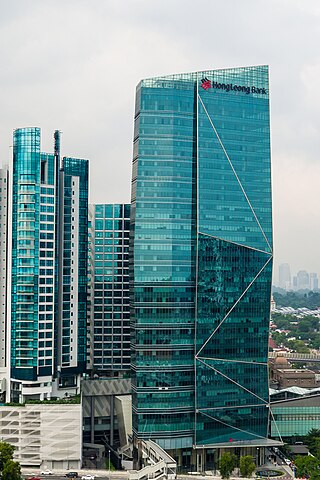
Hong Leong Bank Berhad is a major public listed banking group in Malaysia.

The Leong San TongKhoo Kongsi or "Khoo Kongsi" for short, is the largest Hokkien clanhouse in Malaysia with elaborate and highly ornamented architecture, a mark of the dominant presence of the Chinese in Penang, Malaysia. The famous Khoo Kongsi is the grandest clan temple in the country. It is also one of the city's major historic attractions. The clan temple has retained its authentic historic setting, which includes an association building, a traditional theatre and the late 19th century rowhouses for clan members, all clustered around a granite-paved square. It is located in Cannon Square in the heart of the oldest part of the city of George Town, in the midst of narrow, winding lanes and quaint-looking pre-War houses exuding a palpable old world charm.
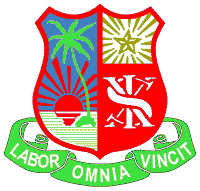
St. Xavier's Institution, at Farquhar Street in George Town, Penang, Malaysia, is the oldest Lasallian school in Southeast Asia and one of the Catholic Lasallian schools in Malaysia. While it has a history dating back to 1787, the present-day institution, named after St. Francis Xavier, was only established in 1852.

The Suffolk House refers to two early residences built on the same site located some four miles west of George Town, Penang, Malaysia. Located on the banks of the Air Itam River, the earliest of the two buildings is notable for having served as the residence of Francis Light, the founder of the first British settlement on Penang. Following Light's death in 1794, and with Penang becoming the fourth presidency of India in 1805, a newer Suffolk House replaced the original house, assuming multiple roles before it was later neglected and subsequently restored.
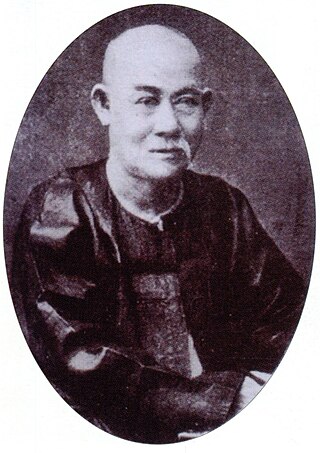
Foo Tye Sin was a Justice of the Peace and an influential community leader of 19th century. Penang born Foo Tye Sin, a British subject, was a Hakka tin miner who could trace his ancestry to the Yong Ting District, Ting Chou Prefecture, Fujian. He was educated at St. Xavier's Institution and the Penang Free School. Tye Sin Street (四条路), or Lebuh Tye Sin as it is now known as, is named after him.
Kapitan China Koh Lay Huan was a wealthy and educated man, who had earlier rebelled against the Manchu-led Chinese Qing dynasty and fled to Siam and the Malay States, to eventually settle in Penang as its first Kapitan China. He was a merchant, planter, tax farmer, Chinese secret society headman, and one of a handful of pioneering leaders of Penang.
Leong Sin Nam, alias Leong Sin, Leung Sin, Leong Sin Hee, was a Malaysian businessman. He migrated and settled in British Malaya in 1898. From humble beginnings, he worked hard to become a wealthy tin mine owner in Perak. He was a businessman, an active community leader and a philanthropist. He was a Chinese revolutionary with similar aspirations as Sun Yat-sen and a strong supporter of the Chinese war efforts during the Sino-Japanese war.

Beach Street is a major thoroughfare in George Town within the Malaysian state of Penang. Part of the city's central business district, it is also one of the oldest streets in Penang, having been created soon after the founding of the state by Captain Francis Light in 1786.

The Pinang Peranakan Mansion in George Town, Penang, Malaysia, is a museum dedicated to Penang's Peranakan heritage. The museum itself is housed within a distinctive green-hued mansion at Church Street, George Town, which once served as the residence and office of a 19th-century Chinese tycoon, Chung Keng Quee.

The George Town Central Business District (CBD) is the financial and political centre of the city of George Town, the capital of the Malaysian state of Penang. The financial district, which was first envisioned by the Penang Island City Council's Local Plan 2030, lies entirely within the city centre, and is home to much of the city's banking and financial services. The term CBD is often used interchangeably with Downtown George Town, encompassing both the historic core and modern sections of the city centre.

Light Street is the oldest road in the city of George Town within the Malaysian state of Penang. It was named after the founder of Penang, Captain Francis Light. As the epicentre of George Town, the street was created soon after Light established the settlement in 1786 and has been serving as a major thoroughfare within the city centre ever since.
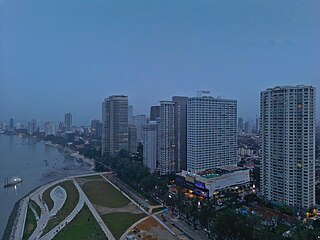
Northam Road is a major thoroughfare along the northern coast of the city of George Town in the Malaysian state of Penang. It continues on from Gurney Drive towards Farquhar Street to the east. Since the 1990s, Northam Road has been part of the city's Central Business District, and along with Gurney Drive, it has seen a significant increase in financial activity.

Leith Street is a narrow road within the UNESCO World Heritage Site of the city of George Town within the Malaysian state of Penang. Once known as an enclave for rich Hakka tycoons, it is home to the famous Cheong Fatt Tze Mansion.

Homestead is a mansion in George Town within the Malaysian state of Penang.
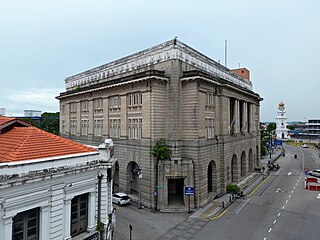
The Standard Chartered Bank building is a historical building in George Town within the Malaysian state of Penang. Completed in 1930, the office building, situated at Beach Street within the city's Central Business District (CBD), was one of the tallest in the city at that time. It served as the Penang branch of Standard Chartered until 2017, after which the bank relocated to its new premise down the street. The building has since been reopened as Spaces Beach Street, one of IWG's coworking spaces in Malaysia.

61 Meyer Road was a bungalow on Meyer Road, Singapore. It was built by Sir Manasseh Meyer, who died shortly after its completion. It then served as the residence of businessman Parkcane C. Hwang.

Woodville is a mansion in George Town within the Malaysian state of Penang. Built in 1925, the building is situated at Northam Road within the city's Central Business District. It was originally the residence of Chinese tycoon Lim Lean Teng. The building is distinguishable from other mansions along the road due to the addition of a dome with a cupola, hastily designed by British architect Joseph Charles Miller.

The Bank of China Building is a historical building in George Town within the Malaysian state of Penang. Completed in 1905, the office building, situated at Beach Street within the city's Central Business District (CBD), originally served as the offices of the Netherlands Trading Society (NTS). Following a series of acquisitions, the building changed ownership multiple times. It was acquired by Algemene Bank Nederland, then by ABN AMRO and the Royal Bank of Scotland. Eventually, it was sold to the Bank of China, which relocated its Penang branch to the building in 2017.

The OCBC Building is a historical building in George Town within the Malaysian state of Penang. Completed in 1938, the office building, situated at Beach Street within the city's Central Business District (CBD), forms part of the Penang branch of the OCBC Bank.

The HSBC Building is a historical building in George Town within the Malaysian state of Penang. Opened in 1951, the office building, situated at Downing Street within the city's Central Business District (CBD), houses the Penang branch of HSBC.




















